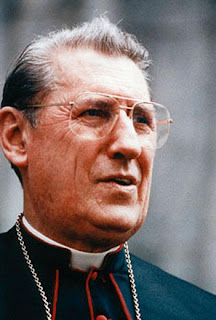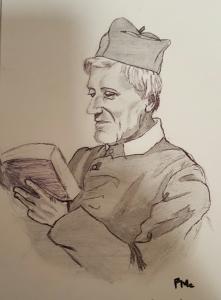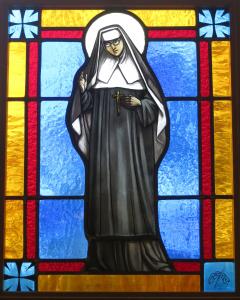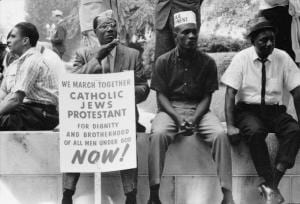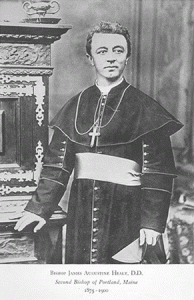Today marks the passing of John Cardinal O’Connor in 2000. EWTN had a nice bio up on their website:
On May 3, John Cardinal O’Connor, the Archbishop of New York, died at his official residence behind St. Patrick’s Cathedral. But his legacy lives on…his words, his concern for the sanctity of life, efforts on behalf of the poor, the sick and the homeless, his defense of the unborn, his concern for his priests and his support for New York’s Catholic schools.
“Every priest would like to be remembered as a priest and all that it conveys, rather than as a public figure with all that it conveys,” Cardinal O’Connor once reflected when asked how he would like to be remembered. He then added, “I regularly go down to the crypt under St. Patrick’s Cathedral and I look at the tombs of my predecessors. Right in the center is the next marble block with no inscription. That’s reserved for me. And all that’s important when I move into the crypt is that I have served New York as a very good priest.” And a very good priest he was.
The Cardinal will be remembered as a strong and faithful shepherd. At a time when Catholics in America were increasingly inclined to take a “cafeteria stand on matters of faith and morals”, Cardinal O’Connor continued to proclaim Church teaching on birth control, abortion and homosexuality.
The one teaching of the Church that defined his ministry was the sanctity of life…at any age and at any stage. He is best known for his stand against abortion. To him, it was simple: Abortion is murder. It is a sin. But he did more than just talk about it. He was committed to the right to life and showed his concern by wearing on the lapel of his black clerical suit a tiny red rose with its stem spelling out “l-i-f-e”. He participated at the annual Right to Life March held in Washington, DC, and formed a religious community, the Sisters of Life who are dedicated to protecting the sacredness of all human life beginning with the infant in the womb to those vulnerable to the threat of euthanasia. In addition, he repeated an offer many times to any woman in need: “go to him for help rather than abort her child”. The Archdiocese of New York and Catholic charities responded by providing hundreds of women with medical assistance, housing, adoption and legal services, as well as, the Cardinal himself counseling women in difficult situations.
Cardinal O’Connor, the fourth of five children, was born in a row house in a blue-collar Philadelphia neighborhood on January 15, 1920. His father, Thomas O’Connor, was his hero and his mother, Mary Gomble O’Connor, experienced both a sudden blindness and recovery that impacted Cardinal O’Connor with a sensitivity to disabled people for the rest of his life.
He attended public schools until he was a junior in high school. Under the Christian Brothers of West Catholic High, he was inspired to take up a religious life. He entered St. Charles Borromeo Seminary in Philadelphia at age 16 and was ordained nine years later on December 15, 1945, a month before his 26th birthday. Cardinal O’Connor and his 21 classmates promised to return for a reunion every year on that date, and the Cardinal kept that promise except for his years in Korea and Vietnam, and last year because he was ill.
He attended public schools until he was a junior in high school. Under the Christian Brothers of West Catholic High, he was inspired to take up a religious life. He entered St. Charles Borromeo Seminary in Philadelphia at age 16 and was ordained nine years later on December 15, 1945, a month before his 26th birthday. Cardinal O’Connor and his 21 classmates promised to return for a reunion every year on that date, and the Cardinal kept that promise except for his years in Korea and Vietnam, and last year because he was ill.
After ordination, he worked as a diocesan priest for seven years. His days and nights were full with teaching at a Catholic high school, night school for adults, hosting a weekly, Catholic, radio news program, and volunteering in two psychiatric hospital wards.
In 1953, Cardinal Spellman, Archbishop of New York, who was also responsible for providing the Church’s chaplains to the U.S. Armed Forces, pleaded for more chaplains. Cardinal O’Connor responded and entered the Navy. When he retired 27 years later, he had risen to Rear Admiral and Chief of Chaplains of the US Navy. Later as an Archbishop and member of the Episcopal Commission that spent two years drafting the American bishops’ 1983 pastoral letter on war and peace, he influenced the bishops in America to tone down criticism of U.S. nuclear policies.
After leaving the Navy in 1979, he was made an Auxiliary Bishop and assigned to the Military Vicarate under Cardinal Terence Cooke of New York. In May 1983 he was appointed Bishop of Scranton, Pennsylvania. He held that post less than a year before being chosen to succeed Cardinal Cooke – who died of cancer – as the Archbishop of New York. He was elevated to Cardinal in May 1985.
After leaving the Navy in 1979, he was made an Auxiliary Bishop and assigned to the Military Vicarate under Cardinal Terence Cooke of New York. In May 1983 he was appointed Bishop of Scranton, Pennsylvania. He held that post less than a year before being chosen to succeed Cardinal Cooke – who died of cancer – as the Archbishop of New York. He was elevated to Cardinal in May 1985.
On his 75th birthday, as required by Church law, he submitted his resignation, but Pope John Paul II asked him to stay on and he did for another five years. On January 16, 2000, the Sunday Mass at St. Patrick’s Cathedral celebrated the Cardinal’s birthday, one day after he turned 80. As he entered the Cathedral, Cardinal O’Connor received a standing ovation from the 3,000 people gathered. During his remarks, the Cardinal said his Sundays in the Cathedral had been among his happiest times.
During his years in the Archdiocese of New York, Cardinal O’Connor was active in many areas – from ministering to both the rich and down trodden, to preaching it was important to live your faith in both politics and even on the baseball field. He would donate his Social Security benefits to a black scholarship fund and give blood to the Red Cross and ask others to “give” too. In the quiet of the night, he was known to visit AIDS patients at an archdiocesan hospital and could be found listening to them, cleaning their sores and changing their bedpans.
Perhaps one person who touched his life most deeply was Mother Teresa. He once stated,
“Mother Teresa offered me one of the most precious gifts that I have received by telling me, ‘Only if we share the light of Almighty God do our lives become truly meaningful.’ ” It is interesting to note that the last public appearance of Cardinal O’Connor was at St. Patrick’s Cathedral on March 5, 2000, when he spoke about Mother Teresa.
The Funeral Mass for John Cardinal O’Connor was held on Monday, May 8, 2000, and he was buried in the crypt beneath the main altar of the Cathedral at St. Patrick’s in New York.

